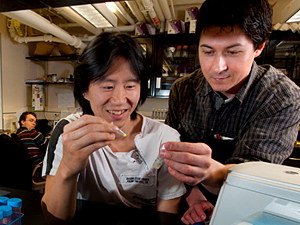How to build a cell

The best way to learn how a car works? Build your own, of course.
And though it's far more complex, the same goes for a living cell.
The most basic thing a cell does is to make a protein based on instructions from a gene. The cell must also break down and recycle molecules of the protein that are defective or no longer needed.
This sequence of chemical reactions takes the work of molecular machinery comprising some 100 enzymes and other molecules. Unfortunately, the sequence goes on for many genes at once, using many of the same molecules.
So it's tough to study a single sequence of reactions; it's like trying to follow an individual thread as a sheet of cloth is woven. Yet what happens to that one thread speaks volumes about the weaving process in general.
That's what drove researchers Vincent Noireaux of the University of Minnesota and Roy Bar-Ziv of the Weizmann Institute of Science (Israel) to isolate and study a single "thread," starting with a gene and leading all the way to the production and breakdown of a protein.
"This work is necessary for developing artificial cell systems," explains Noireaux, an assistant professor of physics. "Artificial cells could be programmed for drug delivery, for example, and we have demonstrated the principle of this.
"Also, it may lead to ways to fix defects of gene expression. In bacteria, it may suggest weak points where one could raise or lower protein production to kill the bacteria or to produce a useful bacterial protein."
Noireaux and Bar-Ziv used extracts from bacteria containing all the molecular machinery necessary for a single gene to function in a test tube. They then studied the speed and other characteristics of the basic processes involved in making and degrading a protein and disposing of "scrap" molecules.
The work is published in the journal Physics Review Letters.
How genes do it
A gene is basically a stretch of DNA. When a gene is active, enzymes "read" its DNA sequence and make a piece of RNA that is essentially a mirror image of the gene. This RNA, called messenger RNA (mRNA), is in turn "read" by a large structure called a ribosome, which constructs a protein based on the information encoded in the mRNA.
But neither mRNA nor protein can be produced indefinitely, or a cell would become glutted. To prevent this, cells also have enzymes that chop up mRNA so its components can be recycled, and other enzymes that do the same for defective proteins or ones that have outlived their usefulness.
Four major steps in gene expression. Graphic by Ranja Sem.
Working with graduate students Jonghyeon Shin (Minnesota) and Eyal Karzbrun (Weizmann), Noireaux and Bar-Ziv studied how the molecular machinery from bacteria carries out these processes.
The balance of life
In one experiment, they examined how the molecular machinery synthesized and degraded a defective protein. They expected that as the defective protein was synthesized and started to build up, the enzyme that degraded it would work proportionally faster. Eventually, the speeds at which the protein was produced and degraded would balance, and the concentration of the protein would stay the same.
Instead, they were astonished to find that the degradation enzyme's working speed had nothing to do with the level of the defective protein in the cell. Even at the lowest level of protein studied, the enzyme responsible for degradation was working as fast as it could but still couldn't keep pace with the rate of synthesis. Consequently, the defective protein accumulated steadily.
This may sound bad, but on the other hand, no living cell should produce a lot of defective protein. Therefore, it may be advantageous that the small level of protein studied—which may be greater than levels found in actual bacterial cells—was enough to spur the enzyme into degrading it at full speed.
"This has implications for how fast genes are expressed—that is, proteins are made from its instructions—and how fast the proteins are degraded," says Noireaux. "Synthesis and degradation are a very fine balance in every organism." Indeed, there are rare human diseases, including some cancers, caused by protein buildup inside cells; in some cases, drugs can stimulate degradation enzymes and relieve symptoms.
In the future, the researchers want to build more complex systems, such as gene circuits composed of more than one gene, and see how the dynamics of genes, mRNA, and proteins play out.
by Deane Morrison
